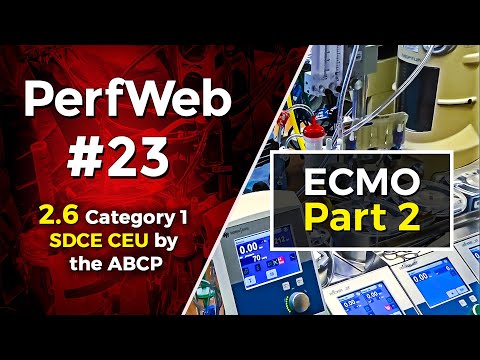Register at : https://library.perfusioneducation.com
Faculty: Joseph Basha, CCP Kimberlee Spurlin, BSN, RN John Ingram, CCP Prakash Balan, MD
0:00—Open
13:06—Kimberlee Spurlin, BSN, RN CRRT Fundamentals
13:49—Continuous renal replacement therapy (CRRT) “Any extracorporeal blood purification therapy intended to substitute for impaired renal function over an extended period of time and applied for or aimed at being applied for 24 hours a day”
14:25—CRRT treatment goals
15:14—Indications for CRRT renal replacement; renal support
16:07—CRRT modes of therapy SCUF (Slow Continuous Ultrafiltration), CVVH (Continuous Veno Venous Hemofiltration), CVVHD (Continuous Veno Venous Hemodialysis), CVVHDF (Continuous Veno Venous Hemodiafiltration).
17:33—Hemofilter: Semi Permeable Membrane (cross section, membrane structure, microscopic membrane structure). 18:31 Diffusion
18:53—Major factors affecting diffusion
19:18—Convection
19:30—Major factors affection convection
19:50—Molecular weights
21:18—CRRT access (vascular access via quinton, inline via ECMO circuit)
25:30—Discussion ECMO and CRRT
1:03:55—ECMO patient selection Prakash Balan, MD
1:04:06—What is ECMO? (ExtraCorporeal Membrane Oxygenation temporary support of heart and / or lung function for reversible disease process)
1:04:27—Goal of ECMO
1:04:35—Oxygen saturation, hemoglobin, cardiac output index, venoarterial
1:04:53—Indication for VA ECMO (failure to Wean from CPB, ischemic , cath lab crash, low C.O IDCM, ischemic, valvular, acute reversible right heart failure, chronic hypotension, intractable arrhythmia, profound vasodilatiory septic shock, sudden cardiac death).
1:06:51—ECMO without myocardial recovery (rapid or “elective” placement on ECMO, stabilize, evaluate, convert to VAD, lung must be ok to use fem- fem VA / V an option combined support and mast be recover to place VAD)
1:07:49—Refractory sudden cardiac arrest (goal, support adequacy).
1:09:10—Refractory sudden cardiac arrest (diagnose and treat underlying cause)
1:11:20—Indication for cardiac support (failure to wean from CPB, acute Myocarditis, cardiac arrest ECPR, Cardiac failure; – diagnosis, treatment, recovery, LVAD BiVAD, transplant).
1:11:51—Indication for cardiac support ( PE with hemodynamic collapse, septic shock, arrhythmia, drug cardiotoxicity, acute MI (cath, stent, cabg), undiagnosed hemodynamic instability).
1:12:18—Contraindication to VA ECMO – known irreversible or untreatable heart / lung disease, adults with severe PAD and vascular access issues, major intracranial hemorrhage (acute), severe or progressive chronic lung injury (prohibitive for surgical intervention), irreparable cong / acquired cardiac disease (bridge), irreversible process (malignancy, end stage lupus)
1:13:42—Goals of ECMO Cannulation – maximum drainage without complication of venous obstruction, unobstructed inflow without distal ischemia, lower risk of infection, maximum mobilisation of the patient, individualization of each patient
1:14:17—VA support – open neck (peds, risk of stroke), transthoracic (failure to wean from CPB), elective transthoracic (profound sepsis), percutaneous (adult, femorals), combination (IJ, RFA)
1:14:34—Arterial inflow sites – aorta (transthoracic), risk of infection(open chest), option to tunel and open chest, risk of dislodgement; carotid (into aorta), risk of stroke, repair); femoral (risk of distal ischemia), axillary (usually using graft)
1:15:05—Arterial ischemia (leg); direct cannulation of common femoral for distal perfusion, retrograde flow into DP / PT, contralateral and to side graft, axillary graft
1:15:18—Special Circumstances – LV venting (VA ECMO); PV, LA appendage (open sternotomy), LV apex (mini L thoracotomy), PA, atrial septostomy; ECPella
1:16:46—VA ECMO with Fem Fem approach; reasonable for cardiac resuscitation but poor for respiratory failure
1:17:31—VA for arrest hemodynamic; support heart with Fem Fem VA; support lungs with addition of VV limb; VAV ECMO
1:52:25—ECMO cannulation strategies – Joseph Basha, CCP
1:55:12—Extracorporeal life support strategies for patients with refractory hypoxemia or hypercarbia
1:57:11—most common VA ECMO
1:57:41—Central Cannulation
2:03:09—Types of ECMO: VV-A ECMO circuit, VA-V circuit, VV-AV circuit, VVV-A circuit
2:09:04—Common Cannulation complication – The “Harlequin” syndrome – flow competition in the aorta (recovering heart vs ECMO pump); if pulmonary function is impaired (“blue head”: deoxygenated blood direct to the upper part of the body. “red legs” oxygenated blood in the lower part of the body); SpO2 probe, blood gases on (right ear lobe / right radial artery); switch to VV ECMO if persistent failure
2:11:18—Distinct effect of circulatory support devices on LV wall stress
2:13:26—LV venting: Ecepella – ecpella (VAECMO plus Impella CP); VA ECMO without CP
2:14:29—Annals of cardiac anesthesia
2:16:55—Tandem heart Protek Duo Cannula
2:21:48—Fem-Fem Configuration; Femor – jugular configuration

